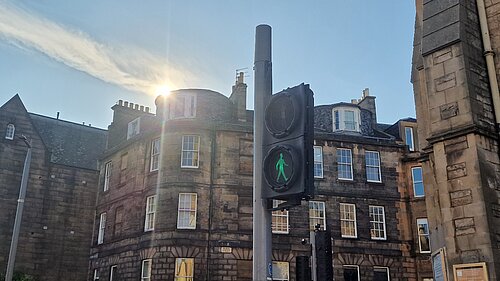Pedestrian crossings on Leith Walk

Background
Contituents have been in touch since I was first elected in 2022 about the short time period to cross a green man on Leith Walk and Elm Row after the tramworks, particularly at the Jane Street, Balfour Street, Pilrig Street, Albert Street, McDonald Road, and Annandale Street three-way junctions. I timed this myself in 2022 and found a junction that at the time was just under 5 seconds of green man.
It is particularly important that pedestrians are able to safely and comfortably cross the road, and vital that individuals with physical disabilities or mobility issues do not feel rushed or get stuck half-way.
Another issue raised was the variable wait times for pedestrians, where at times multiple loops of green lights for vehicles in one direction would signal before the green man went on.
In November 2023, I submitted the following questions for the-then Transport and Environment Convenor:
Question 1: Answer 1: The actual value is calculated based of half the width of the road divided 1.2m/s plus an additional 2 seconds to get pedestrians beyond the halfway point. If the value calculated is below 6, then the minimum of 6 is used. If above 6 then that value is used. At Puffin and Toucan crossings there is a slightly different criteria for the green man time, as the these have near sided display units. These use 4/5 seconds green man as once pedestrians have established themselves on the crossing the green man is no longer visible. Consideration is given based on the criteria below if there is a requirement to increase the green man further up to a maximum of 9. At these crossings again it is the clearance time that allows pedestrians to clear the crossing area. Above ground detection is used to detect pedestrians on the crossing |
|---|
| Question 2: How can residents, councillors and stakeholders such as Living Streets feed into City Mobility Plan action W10 (Longer Crossing Opportunities) and W11 (Increased Green Man Call Opportunities) to ensure their local crossing lights can be assessed? Answer 2: A three-month consultation was undertaken earlier this year on City Mobility Plan draft Action Plans, with the results of this consultation reported to Transport and Environment Committee on 12 October. The final version of the Active Travel Action Plan is currently scheduled to be considered by Committee on 1 February 2024 and will include further information on how it is proposed to take these actions forward. |
|---|
Further conversations have happened since.
Present
In November 2024, the Council's Traffic Signals team rolled out a more streamlined system down Leith Walk which brought consistency to the order of “phases”, ensuring that the green man would light up at least once per cycle.
Additionally, engineers have been on site and confirmed that the green man is now on for 6 seconds, followed by a 17 second “intergreen period” (time before the next road light goes green and traffic can move). So although the green man only shows for 6 seconds, it's worth noting the extra time you can allow yourself to cross.
Lastly, engineers have adjusted the timing on the McDonald Road junction to stop an issue where the green man went on while some vehicles were still filtering through.
It's been a bit of a journey, but I'm grateful for the engagement from traffic engineers to get the above 3 improvements.
